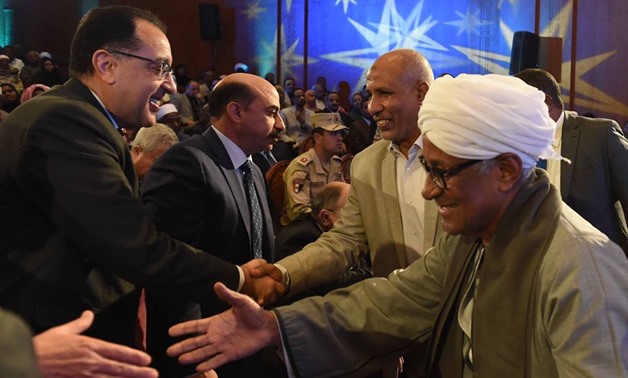
Prime Minister Mostafa Madbouli on Monday attended a celebration in Upper Egypt’s Aswan to pay Nubian people the compensation they deserve, as they were displaced by the construction of the two Aswan dams since 1902 - Courtesy of the Council of Ministers
CAIRO – 20 January 2020: Prime Minister Mostafa Madbouli on Monday attended a celebration in Upper Egypt’s Aswan to pay Nubian people the compensation they deserve, as they were displaced by the construction of the two Aswan dams since 1902.
A number of ministers, including Social Solidarity Minister Nevin Al-Qabbaj, Culture Minister Enas Abdel Dayem, and Housing Minister Assem El-Gazzar also attended the celebration.

During the celebration, Mabouli said he participated to voice the political leadership and government’s keenness to develop Upper Egypt and address its issues,
Madbouli referred to the major development projects that the government has implemented over the past few years in Upper Egypt, in terms of roads, electricity, housing, drinking water, sanitation, education and health.
He also affirmed the support of the political leadership to the Nubian people, in an effort to resolve their problems by finding radical solutions to the issues they face.



 Compensation plan
Compensation plan
Egypt's President Abdel Fatah al-Sisi earlier ordered addressing the problems of Nubian people affected by the construction of the two dams, including the Aswan Low Dam since 1902 and the Aswan High Dam in the 1960s.
In July last year, the number of Nubian people who have applied for compensation in Aswan has reportedly reached 1,590 people. This comes as the committee formed to receive compensation requests starting June 25 has announced extending the deadline until the end of July.
The Cabinet formed a committee headed by the Ministry of Justice in 2017 to determine those entitled to be compensated from people in Nubia, said Omar Marwan, then-Minister of Parliamentary Affairs. It was found that 11,716 people are eligible for compensation.
Those who deserve compensation include 3,851 people affected by the construction of the Aswan reservoir, while 7,865 people were affected by the construction of the Aswan Dam, he said.
Some others had already received compensation. After counting those who deserve the compensation, the government opened the door for appeals and requests in order to compensate the rest of affected Nubians, he added.
Asked about the type of compensation, Marwan said that the affected Nubians will receive lands, houses or cash, adding that agricultural lands and houses will be granted to those affected by the construction of the Aswan Dam.
Concerning the reservoir, the affected people have already built houses on the land of the state, Marwan said, adding that the government will grant them the legal ownership of these lands. Moreover, those who built houses on lands near rivers including islands will be given the right to use these lands forever for free.
Marwan said earlier that each of the affected persons has the entitlement to apply for cash compensation of LE 25,000 ($1498) per feddan.
The affected people will be compensated by other lands, as some of them deserve arable lands while others deserve lands for housing units.
The story
Years ago, Egypt's former President Gamal Abdel Nasser instructed to build Egypt’s biggest national project, the High Dam.
 Egyptian President Gamal Abdel Nasser observing the Nile River excursion zone at the construction site of the Aswan High Dam - Biblioltheca Alexandria
Egyptian President Gamal Abdel Nasser observing the Nile River excursion zone at the construction site of the Aswan High Dam - Biblioltheca Alexandria
The High Dam was built under the name of Aswan Dam. It was mainly meant to generate power and regulate the seasonal flooding of the Nile. Being one of the former leader’s greatest achievements for the Egyptians, especially the farmers, the dam was a dream that came true as people have suffered for years from the loss of their crops due to the seasonal unexpected floods.
The establishment of the Dam started with Aswan Dam/reservoir in 1902. The increasing rate of water flow behind the dam flooded 44 Nubian villages and displaced 18000 Nubian families in the aftermath. The area is known now as “old Nubia”.
Nubians who deserted their houses and saw them sink beneath the rising water had to migrate to Kom Ambo area known as “New Nubia”. The biggest migration took place when the construction of the High Dam occurred in 1963. Nubians witnessed a shift in the way of life around the Nile to a new desert life in villages built for them in Kom Ambo.
 FILE - Aswan Dam - Wikimedia Commons/Orlova-tpe, 2012
FILE - Aswan Dam - Wikimedia Commons/Orlova-tpe, 2012








Comments
Leave a Comment